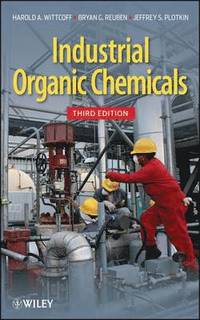
- Format
- Inbunden (Hardback)
- Språk
- Engelska
- Antal sidor
- 848
- Utgivningsdatum
- 2013-01-04
- Upplaga
- 3 ed
- Förlag
- John Wiley & Sons Inc
- Medarbetare
- Wittcoff/Plotkin/Reuben
- Illustrationer
- Illustrations
- Dimensioner
- 236 x 157 x 46 mm
- Vikt
- Antal komponenter
- 1
- Komponenter
- 52:B&W 6.14 x 9.21in or 234 x 156mm (Royal 8vo) Case Laminate on White w/Gloss Lam
- ISBN
- 9780470537435
- 1271 g
Industrial Organic Chemicals
- Skickas från oss inom 5-8 vardagar.
- Fri frakt över 249 kr för privatkunder i Sverige.
Passar bra ihop
De som köpt den här boken har ofta också köpt Co-Intelligence av Ethan Mollick (häftad).
Köp båda 2 för 2137 krKundrecensioner
Fler böcker av författarna
-
Organic Chemistry Principles and Industrial Practice
Mark M Green, Harold A Wittcoff
Nylon, plexiglas, epoxy resin, and Elmer's glue; dynamite, rubber tires, and spandex. These are a few among the multitude of industrial products produced using the principles of organic chemistry, principles that are often taught to students ...
Recensioner i media
The book presents its information with concepts of sustainability and climate change in mind, covering green chemistry and renewables, including research into processes (such as electricity generation) that produce less or no carbon dioxide. (Chemical Engineering Progress, 1 January 2013) Every organic chemist who contemplates a career in the field should read the book. Even future and active pharmaceutical researchers will need the chemical insight from this book to understand the nature of their starting materials. Summing Up: Highly recommended. Upper-division undergraduates through professionals/practitioners. (Choice, 1 October 2013)
Övrig information
HAROLD A. WITTCOFF has taught industrial organic chemistry at the University of Minnesota, while serving as Vice President of Corporate Research for General Mills Inc. As scientific adviser to Nexant ChemSystems, he has presented 300 courses in industrial chemistry in twenty-eight countries. The late BRYAN G. REUBEN was Professor Emeritus of Chemical Technology at London South Bank University, and was the author or coauthor of 130 publications and a single patent. JEFFREY S. PLOTKIN is Vice President, Chemicals and Technology, at Nexant ChemSystems and is the author or coauthor of twenty-five technical publications and thirty patents.
Innehållsförteckning
Preface xxiii Preface to the First Edition xxv Preface to the Second Edition xxvii Acknowledgments xxix Bryan Godel Reuben 19342012 xxxi List of Acronyms and Abbreviations xxxiii Introduction: How to Use Industrial Organic Chemicals, Third Edition 1 I.1 Why This Book Was Written and How It Is Structured 2 I.2 North American Industry Classification System 5 I.3 Units and Nomenclature 5 I.4 General Bibliography 6 1. The Evolution of the Organic Chemicals Industry 13 1.1 The National Economy 13 1.2 Size of the Chemical Industry 16 1.3 Characteristics of the Chemical Industry 22 1.4 The Top Companies 43 1.5 The Top Chemicals 44 2. Globalization of the Chemical Industry 49 2.1 Overcapacity 51 2.3 Participation in International Trade 63 2.4 Competition from Developing Countries 66 3. Transporting Chemicals 71 3.1 Shipping Petroleum 71 3.2 Shipping Gas 74 3.3 Shipping Chemicals 75 3.4 Health and Safety 86 3.5 Economic Aspects 87 3.6 Trade in Specific Chemicals 88 3.7 Top Shipping Companies 90 4. Chemicals from Natural Gas and Petroleum 93 4.1 Petroleum Distillation 97 4.2 Shale Gas 100 4.3 Naphtha Versus Gaseous Feedstocks 102 4.4 Heavier Oil Fractions 103 4.5 Steam Cracking and Petroleum Refining Reactions 104 4.6 Catalytic Cracking 114 4.7 Mechanisms of Steam and Catalytic Cracking 117 4.8 Catalytic Reforming 119 4.9 Oligomerization 122 4.10 Alkylation 124 4.11 Hydrotreating and Coking 125 4.12 Dehydrogenation 126 4.13 Isomerization 128 4.14 Metathesis 128 4.15 Function of the Refinery and the Potential Petroleum Shortage 133 4.16 Separation of Natural Gas 136 4.17 Oil from Tar Sands 137 5. Chemicals and Polymers from Ethylene 139 5.1 Ethylene Polymers 141 5.2 Ethylene Copolymers 151 5.3 Oligomerization 154 5.4 Vinyl Chloride 160 5.5 Acetaldehyde 165 5.6 Vinyl Acetate 167 5.7 Ethylene Oxide 169 5.8 Styrene 177 5.9 Ethanol 181 5.10 Major Chemicals from Ethylene A Summary 182 5.11 Lesser Volume Chemicals from Ethylene 185 6. Chemicals and Polymers from Propylene 211 6.1 On-Purpose Propylene Production Technologies and Propane Dehydrogenation 214 6.2 Main Polymers and Chemicals from Propylene 217 6.3 Oligomerization 221 6.4 Acrylic Acid 222 6.5 Acrylonitrile 227 6.6 Cumene/Phenol and Cumene Hydroperoxide 231 6.7 Acetone and Isopropanol 233 6.8 Propylene Oxide 242 6.9 n-Butyraldehyde and Isobutyraldehyde 255 6.10 Major Chemicals from Propylene A Perspective 261 6.11 Lesser Volume Chemicals from Propylene 263 7. Chemicals from the C4 Stream 273 7.1 Chemicals and Polymers from Butadiene 277 7.2 Chemicals and Polymers from Isobutene 296 7.3 Chemicals and Polymers from 1- and 2-Butenes 302 7.4 Chemicals from n-Butane 303 8. Chemicals from the C5 Stream 309 8.1 Separation of the C5 Stream 311 8.2 Isoprene 312 8.3 Cyclopentadiene and Dicyclopentadiene 319 8.4 Pentene-1 and Piperylene 321 9. Chemicals from Benzene 323 9.1 Phenol 326 9.2 Cyclohexane 344 9.3 Aniline 354 9.4 Alkylbenzenes 361 9.5 Maleic Anhydride 362 9.6 Chlorinated Benzenes 363 9.7 Dihydroxybenzenes 364 9.8 Anthraquinone 370 9.8.1 Hydrogen Peroxide 371 10. Chemicals from Toluene 375 10.1 Hydrodealkylation, Disproportionation, and Transalkylation 375 10.2 Solvents 378 10.3 Dinitrotoluene and Toluene Diisocyanate 378 10.4 Lesser Volume Chemicals from Toluene 380 11. Chemicals from Xylenes 383 11.1 o-Xylene and Phthalic Anhydride 386 11.2 m-Xylene and Isophthalic Acid 395 11.3 p-Xylene and Terephthalic Acid/Dimethyl Terephthalate 397 12. Chemicals from Methane 407 12.1 Hydrocyanic Acid 408 12.2 Halogenated Methanes 411 12.3 Acetylene 417 12.4 Synthesis Gas 424 12.5 Chemicals from Synthesis Gas 429 12.6 Carbon Monoxide Chemistry 454 12.7 Gas-to-Liquid Fuels 459 13. Chemicals from Alkanes 463 13.1 Functionalization of Methane 464 13.2 Functionalization of


